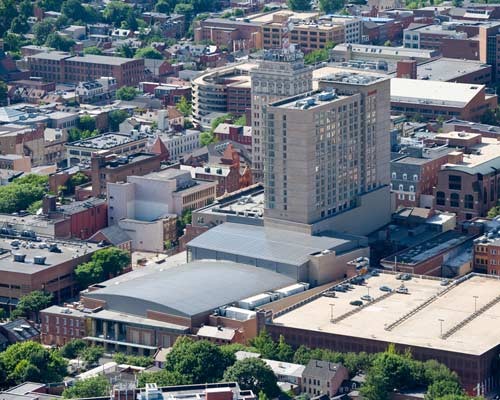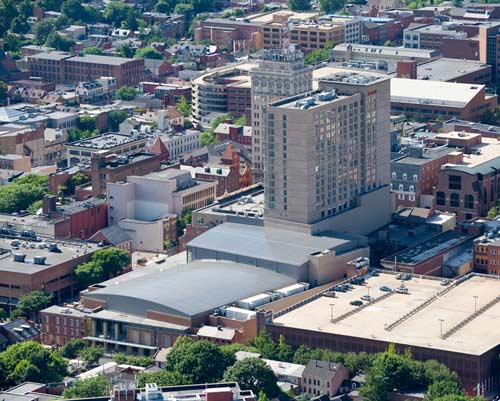 It’s hard to blame Tim Carr for doubting a hotel and convention center would ever tower over Penn Square in the heart of Lancaster.
It’s hard to blame Tim Carr for doubting a hotel and convention center would ever tower over Penn Square in the heart of Lancaster.
The dual venue was conceived in the late 1990s as a way to jumpstart the city’s revitalization. But backers spent the next decade stumbling over a series of legal and financial hurdles before finally unveiling the finished product on June 19, nearly two months behind schedule.
“To be perfectly honest, I was planning in my mind way back when that the convention center wasn’t going to be built and life was going to be OK,” says Carr, who owns Carr’s Restaurant, in a basement space about half a block from Penn Square.
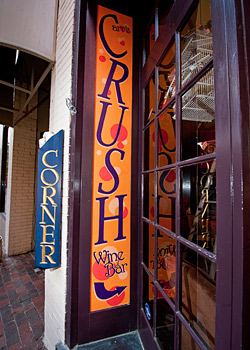 Now, Carr plans to open what may be the city’s first wine bar, Crush, above his restaurant. He anticipates steady traffic from the $178 million hotel and convention center, which rises up 19 floors behind the carefully preserved art-deco facade of the former Watt & Shand department store.
Now, Carr plans to open what may be the city’s first wine bar, Crush, above his restaurant. He anticipates steady traffic from the $178 million hotel and convention center, which rises up 19 floors behind the carefully preserved art-deco facade of the former Watt & Shand department store.
Once it starts operating at full tilt, the development is expected to bring up to 150,000 new guests per year to downtown Lancaster, with big events spilling into surrounding hotels. The publicly owned Lancaster County Convention Center houses about 90,000 square feet of meeting space, including a 45,000-square-foot exhibition hall. The interconnected but privately owned Lancaster Marriott at Penn Square boasts 299 rooms. Paintings and photographs from local artists hang from every wall.
“When the economy does get better, having that hotel there will be a big deal, ” Carr says. Still, he says, he likely would have opened the wine bar even if the hotel and convention center had remained little more than a pretty drawing on someone’s desk.
His view is a testament to what has taken place over the last few years in Lancaster, a city that most people discover only if they get disoriented on their way to Amish country or the outlet malls. The hotel and convention center are the latest ingredients, albeit huge ones, in Lancaster’s resurgence–and a new excuse for outsiders to discover the city.
“I describe them as the gravy on top of a very nice meal that we’ve been cooking here for the last four or five years,” says Philip R. Wenger, president of Lancaster-based Isaac’s Restaurant & Deli, a chain of 20 family restaurants dotting central Pennsylvania.
Wenger opened his first Isaac’s in downtown Lancaster 26 years ago. It was a time of pessimism in the city, he says. “We were fighting a losing battle.” The prevailing mood today is optimistic.
Wenger gives some of the credit to local arts organizations, ranging from the Fulton Opera House to the Pennsylvania College of Art and Design. The impetus also comes from the James Street Improvement District, a group created by Franklin & Marshall College and Lancaster General Hospital to make over the city’s northwest quadrant. Private galleries and other businesses have also helped turn the city into a cultural destination.
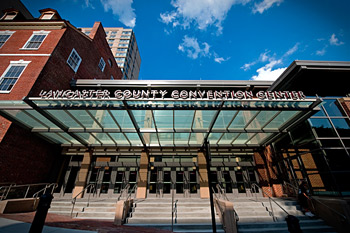 Wenger gives another nod to the growing preference among many people for a more-urban lifestyle. “There has been a steady, steady drumbeat of positive energy,” he says.
Wenger gives another nod to the growing preference among many people for a more-urban lifestyle. “There has been a steady, steady drumbeat of positive energy,” he says.
Wenger and Isaac’s are contributing to the energy. The chain’s flagship restaurant on South Queen Street is less than a block from the convention center. Last summer, it opened a 12-seat bar and started hosting live performances in a public plaza next door.
Wenger’s goal is to boost the restaurant’s bottom line, which still lags behind its suburban counterparts, particularly on nights and weekends. Business picked up slowly at first, but spiked 20 percent to 25 percent after the hotel and convention center opened, Wenger says.
The hotel and convention center may be launching in the middle of a sharp recession, but Wenger and others were not overly concerned. “I think it is such a unique product, exceptionally well-done, in a market that’s ripe for the venue,” Wenger says. He expected Lancaster to emerge as a viable alternative to cities like Austin, Texas, and Nashville, Tenn.
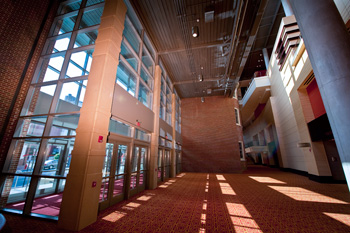 A big source of business for the convention center is expected to be statewide associations that typically rotate their meetings among Pennsylvania cities. “We haven’t been on their radar screen for a long time,” says Josh Nowak, the venue’s sales and marketing director.
A big source of business for the convention center is expected to be statewide associations that typically rotate their meetings among Pennsylvania cities. “We haven’t been on their radar screen for a long time,” says Josh Nowak, the venue’s sales and marketing director.
Indeed, one of the hall’s first large groups was the Pennsylvania League of Cities and Municipalities. The group held its annual meeting at the convention center in late June, bringing in roughly 300 mayors and city council members from around the state.
Initially, many chose to hit the streets instead of attending official sessions, says Lancaster Mayor Rick Gray. “People were discovering… that there was actually a city here.”
The challenge now is making sure that city has enough restaurants and other services to handle even larger events. A barbershop-quartet competition could bring up to 4,000 visitors this fall. “If everybody wants to eat at noon, we’re in trouble,” Gray says.
Joel Berg is a freelance writer, part-time writing teacher and recovering business reporter living in York. Send feedback here.
To receive Keystone Edge free every week, click here.
Photos:
Aerial view of the new Lancaster Convention Center
Tim Carr’s Crush Wine Bar
Entrance to the Convention Center
Convention Center main Corridor
All Photographs by Glenn Usdin
